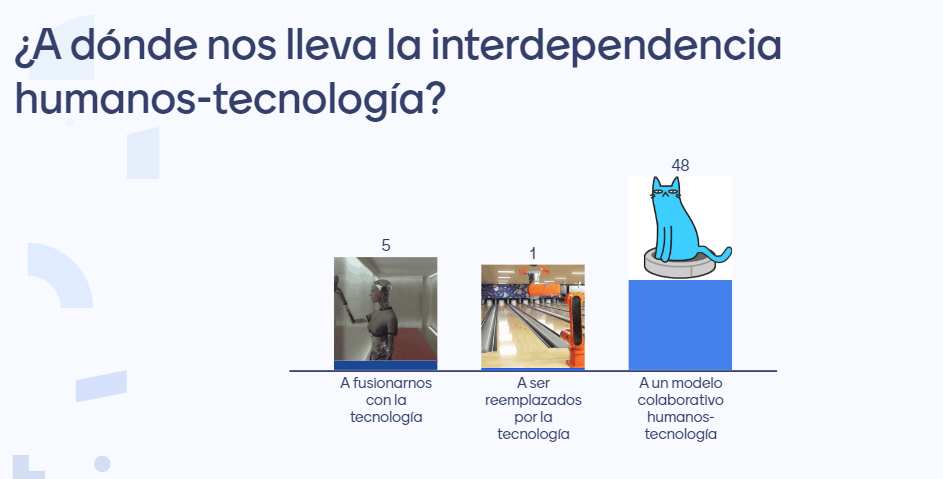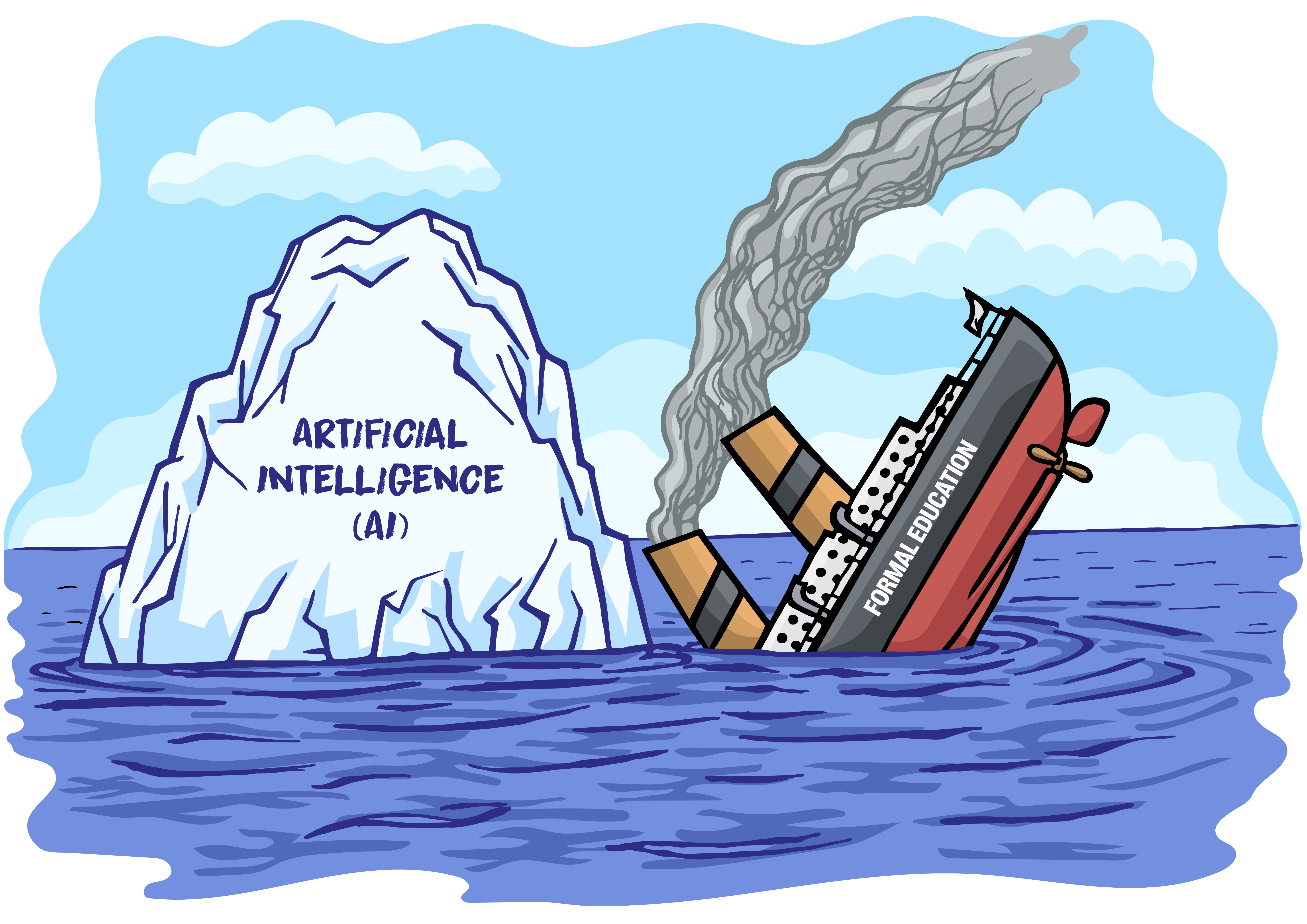Formal education is a massive ship like the Titanic that moves fast, but its size allows little maneuverability; thus, it is difficult to change course quickly. Technological advances in artificial intelligence (AI) represent a giant iceberg threatening the current education paradigm. How can we all end up on this ship about to hit the iceberg? Find out in this article.
In this webinar of the Observatory of the Institute for the Future of Education (IFE) at Tecnologico de Monterrey, we had the opportunity to learn from Professor Hernán Mavrommatis from the University of La Matanza in Argentina. He reflected on current technological trends, specifically advances in artificial intelligence and its potential to transform formal education, using ingenious analogies and the sense of humor that characterizes him. His inspiring presentation presents another perspective on the vertiginous changes we are experiencing in the educational field; he shares valuable advice and optimism to face our future challenges. If you did not have the opportunity to follow the live broadcast, I invite you to enjoy this engaging session and share it with your colleagues.
“The ‘wisdom’ connected to a click away, as well as the fear of copying and plagiarism, is not a scenario we haven’t experienced before.”
Following the analogy raised at the beginning of the article, that ship in which we all “sail,” whose technology (the steam engine) promoted the industrial revolution that later had a significant influence on how we organize learning through an industrial model, has endured for many years. In a certain way, we have become accustomed to seeing or designating the teacher (many times involuntarily the teacher) as the only source and transmission of knowledge in the classroom. We have lived in this context for a long time that conditions how we plan, organize, and prepare to learn.
For some people, recent advances in AI seem like something almost magical; this is one of the first ways we tend to think of when we want to explain something new to us; The science fiction writer Arthur C. Clarke (1962) already said that “any sufficiently advanced technology is indistinguishable from magic.” For others, on the other hand, AI is a kind of threat that “clashes” with what is established, being reluctant to change and making it difficult to adopt and incorporate it into different activities. Professor Hernán explained this in the Observatory webinar.
“For formal education not to clash with AI, we must stop using the industrial model and forget to consider ourselves as machines that transmit knowledge.”
He also told us that we were not experiencing a scenario that we had not experienced before. The fear of copying, plagiarism, the “wisdom” connected to a click away… is something that we had already experienced, even feared… until we adopted it. Such was the case of the internet half a century ago and later the most famous search engine Google a quarter of a century ago. Recently, during the COVID-19 pandemic, we significantly used these tools in many aspects of life that we had not experienced in a massive way, such as working from home and virtual or remote education. However, despite its adoption, we still have learning challenges, and the methodologies we can use for students
to learn are still very relevant.
Rose and Jack represent the teachers and students in this fun analogy with the Titanic movie. Like the characters in the movie, they have different outlook on life with different interests and ways of learning. For example, students find it hard to believe that many of us teachers did not have access to the internet or YouTube, that many of us turn to encyclopedias or libraries to learn, and that we hand in handwritten lab reports. How to get students interested in our proposals without them “dying” of boredom?
Below are tips Professor Hernán shared in the IFE Observatory webinar regarding better relating to students.
- Arouse curiosity in students with interesting analogies and humor.
- Motivate students to learn.
- Present them with a challenge that provokes them to investigate, ask, and question themselves.
- Generate a culture that embraces the new and the unknown using critical thinking, the scientific method, and argumentation.
- Use humor, anecdotes, and analogies. Encourage students to do the same.
Where is human-technological interdependence taking us? The statistics regarding teachers’ thinking about human-technology interdependence are: a) 9% We are fusing with technology; b) 2% Technology is replacing us; and c) 89% We are developing a collaborative human-technology model (See Image 1.)

For formal education not to clash with AI, we must stop using the industrial model and forget to consider ourselves as machines that transmit knowledge. Professor Hernán encourages us to do the following in class activities:
- Use error as an opportunity to improve and advance, starting with the teachers themselves.
- Create a psychologically safe environment for free expression without facing ridicule or destructive criticism.
- Use the body and mind, and employ self-observation of our thoughts.
- Provide feedback to students.
- Use social games to generate ideas and solve problems.
- Encourage divergent thinking.
- Explore ways to relate to the students as humans through humor and emotions.
Professor Hernán Mavrommatis invites us to complement learning by exploring the benefits of AI and incorporating our human roots in education, using our emotions, mood, feelings, and body to communicate knowledge. Also, he says to strengthen relevant human aspects, such as the need for autonomy, competency, belonging to a group, empathy, and many more things that make us unique and irreplicable.
Review this webinar. If your native language is not Spanish, you can activate the subtitles on YouTube to see a webinar translation. To activate this option, on YouTube, select Subtitles (subtitles will appear in Spanish), then select Settings ->Subtitles -> Translate Automatically, and then choose the language you prefer.
Hernán Mavrommatis (mavromou@gmail.com ) has more than twenty years of teaching experience. He holds a Master’s in Management of Technological Services and Telecommunications (UdeSA). He is head of the course “Entrepreneurship and Innovation” (UNLaM) and a professor at different public and private universities. A researcher in education, he has more than a dozen articles published on creativity in congresses, magazines, and books. He was a TEDxUNLaM speaker, presenting the talk: “A Bear, a Donkey, and an Engineer: Creativity and Humor in Learning.” He is preparing a thesis on creating humor for the Master’s Degree in Cognitive Psychology and Learning (FLACSO-UAM).
This article from Observatory of the Institute for the Future of Education may be shared under the terms of the license CC BY-NC-SA 4.0 
)
)


)